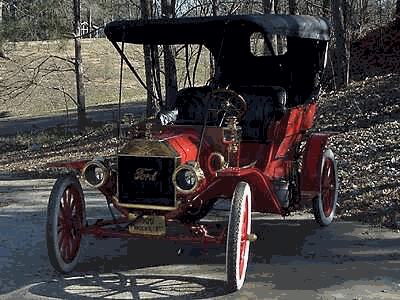
Ford Model T, 1909, Red. The first Model Tís featured
colors.
|
The concept of personal taste and a need to express oneís individuality
is not new; it has arguably existed since the dawn of mankind.
One of the ways people express themselves is through their possessions.
Known as the "second-most expensive purchase" most
Americans make today, the automobile is used by many people
to express themselves. Apart from the type (sedan, convertible,
minivan, sport utility vehicle, etc.) and the make of the car
(Chevrolet, Chrysler, Ford, Toyota, etc.), the most important
factor used by individuals to determine their automotive purchase
is the color or hue of the car. Often, customers hinge their
final decision to purchase a certain vehicle based on the customerís
reaction or perception about the color. Most car buyers will
not have a problem finding a favorable color that matches their
preferences. Aside from custom paint jobs available in the aftermarket
automotive industry, most car manufacturers in the United States
today offer a widespread selection of colors, covering practically
every shade of the color spectrum. However, most car colors
currently offered by manufacturers are darker shades of red,
green, and blue, as well as silver, black, gray/silver, white,
and beige/gold. A few sports cars and "youth-oriented"
cars may offer less traditional colors such as yellow, violet,
and bright orange. Due to large advances in the automotive painting
process, different types of coating such as "clearcoat,"
"metallic," and "pearl coat" allow for more
variances in color.
However, the current wide range in colors available to
automotive consumers was likely not available to customers purchasing
a car at the turn of the 20th century. Neither was
the spectrum of colors offered to customers during the 1950s
the same as the spectrum offered today. How, then has the automotive
color palette changed in the decades following the advent of
the automobile? And what are the possible reasons for its development
over the last century? Simply put, the evolution of color in
the American automobile in the last century has been determined
by economic issues facing the automaker, the national mood reflected
in consumers, and the consumersí tastes.
|
|
During the infancy of the automobile in the US, from the 1890s
to the early 1900s, color was not an important issue to automakers.
The automobile was in its earliest developmental stages, and
the novelty of owning an automobile was distinctive enough for
most wealthy customers who were able to afford a car. During
this period, the Duryea Brothers developed the first car in
the US, and Ransom Olds began to sell the first successful American
automobile, the Curved Dash Oldsmobile. Henry Ford of Detroit,
engineered his first car, the Quadricycle, and soon began developing
production cars for his Ford Motor Company. The first cars were
unpainted; if painted they were often painted dark gray or black.
Black paint was used primarily because it was the least expensive.
However, it is also likely black paint was used naturally because,
during the gilded age, most machinery and objects of transportation,
from carriages to steam railroads to iron-clad steamships were
painted black. Black cars were also conspicuous. In the late
1890s and early years of the 1900s, laws in many American cities
required cars or "motorized or horseless carriages"
to travel no faster than 7 miles per hour and be escorted by
a person walking in front with a flag, warning people of the
approaching automobile.
Nevertheless, most production cars by the end of the first
decade of the 1900s offered a selection of at least a few colors,
such as red, green, gray, and black, mostly in the darker shades.
However, as automobiles were still considered a "toy of
the wealthy," automotive color did not hold much importance
for the average consumer. It is common legend that Henry Ford
once said something of this nature: "A customer may have
a car in any color he desires, so long as its black." Today,
many people have taken this quote to mean that every Model T
Ford, the car which undoubtedly made the American automobile
affordable and "put America on wheels," was painted
black. This is not the case. From 1908 to 1914, Model T Fords
were painted in a variety of 4 to 5 available colors. All colors
of were of darker shades. Interestingly enough, black was not
offered as a color initially. However, from 1914 to 1926, all
Model T Fords were indeed painted black. The reason behind this
color choice was purely economic: Ford wanted to produce the
most number of automobiles in the least amount of time. Because
black paint at the time was the least expensive and dried the
fastest, black paint allowed Ford to produce a car in about
90 minutes Ė and satisfy the nationís hunger for personal transportation
at a relatively inexpensive price.
|
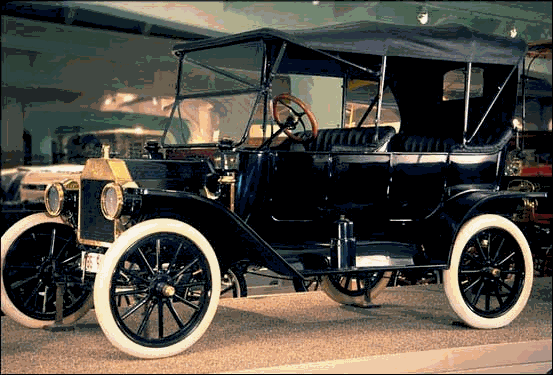
A ~1915 Model T Ford, Black. From 1914-1926, there
were only Black Ford Model Tís.
|
The 1920ís saw the first use of color to reflect
personal taste. The economic boom of the period (the "Roaring
Twenties") following World War I, increased the demand
for automobiles. With cars becoming a common sight on roads,
buyers began to fatigue of the black-colored car. While Ford
maintained selling its black Model Tís for most of the decade,
other manufacturers such as General Motors began to introduce
competitive affordable cars that included the availability of
different colors; the average consumer was able to afford to
personalize his car for the first time. Most colors were still
very traditional, and darker maroons, blue, and greens were
popular with lower priced cars such as Chevrolets. More expensive
cars such as Buick, Cadillac, or Packard began to offer cream
or tan colored cars. Ford, at the risk of appearing backward,
rushed to reintroduce colors into its Model T and subsequent
models, when its sales plummeted in the 1920s. Nevertheless,
the mass introduction of traditional color into automobiles
during the 1920s was a result of the acceptance of the automobile
into American society and the beginning of the interest in personalizing
oneís car.
|
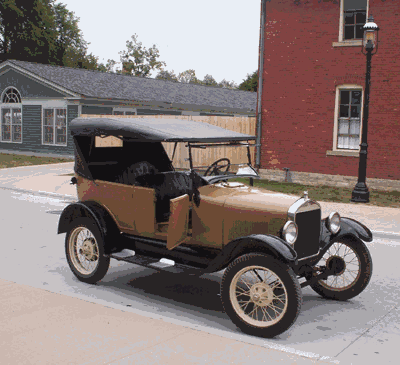
A 1926 brown Model T Ford.
Colors were offered again by Ford in 1926 due to competition and a
more efficient painting process.
|
The 1930s and 1940s saw dramatic change in
automotive style, and an expansion in colors that accompanied
it. During this period, more cars became more streamlined and
cars began to look less like horseless carriages. Accompanying
this change was a greater expansion in colors, with more variance
in shades available. For the first time, buyers could find cars
with several different shades of blue, green, or red. Colors
also became brighter and less associated with darker, black-like
colors. However, the 1930s in particular were marked with greater
economic troubles for both the automobile companies and the
buying public, due to the fallout from the Crash of 1929 and
the economic downtown, or Great Depression, that followed. It
was during this period that the greatest number of automobile
manufacturers were forced to liquidate their assets and close
shop. Many of the smaller companies catering to a small group
of wealthy clientele were devastated, and with their disappearance
the abundance of colors such as cream and tan slightly decreased.
|
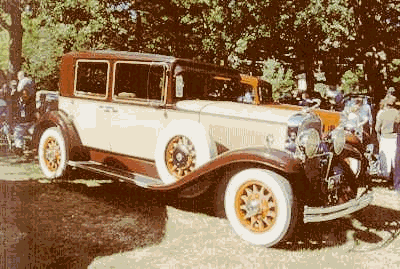
A 1930 tan/brown LaSalle.
An example of cream-colored, more expensive automobile of the
time. |
|
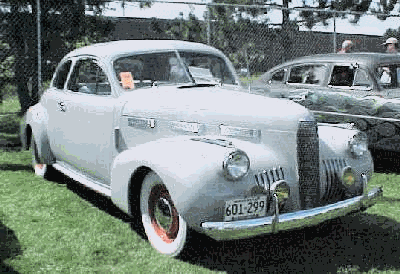 A 1939 white LaSalle. White was always an automotive
color staple.
A 1939 white LaSalle. White was always an automotive
color staple. |
|
The mid-1940s saw a change in the automobile
industry to mobilize for war. During Americaís involvement in
World War II, for a couple year period, civilian American automobile
production completely ceased. Car companies switched to producing
military vehicles or producing engines for planes or other equipment.
However, immediately before the war, when fuel rations were
imposed on the public, most American automobile manufacturers
sold "blackout" models in the face of the impending
war. These cars were black, and were very stark and conservative;
they lacked any chrome or aesthetic ornamental embellishment.
|
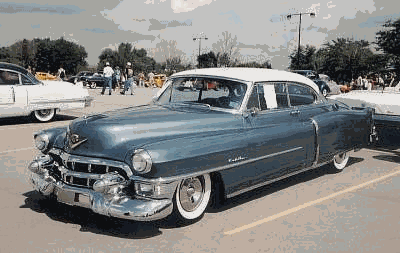
1953 Cadillac Coupe de Ville, Blue/White.
New types of paint based on trends and fashion became popular during
the Fifties.
Two-tone paint was common.
|
During the 1950s, there was a return to an
interest in automotive style. Automotive design was a reflection
of adventure, success, a post World War II feeling of euphoria,
and for the first time, fashion. Features such as the curve-around
windshields and the tailfins were monikers of this renaissance
in design. Colors offered to buyers in this period reflect these
design sentiments. Along with generous amounts of chrome, colors
included bright colors in many shades of blue, red, green, gold,
as well as white and black. Many colors were also arranged in
two-tone arrangements for the first time; the body of the car
and the roof were painted different colors, or one part of the
bottom was painted a different color than another part of the
body. In most cases, one color was dark and the other color
was a light color such as white, or synthetic faux wood. The
effects of fashion played an important role for car colors as
well. Manufacturers were inspired to match colors for a car
based on ivory, or jewels, for example. Cadillac advertisements
from the 1950s commonly drew on this automotive-fashion link.
However, some attempts to follow fashion greatly failed. One
such example was the Dodge "LaFemme," a model supposedly
marketed as a "womenís car" with pink paint, and special
umbrella and lipstick holders. Pink-colored cars have rarely
been offered since.
|
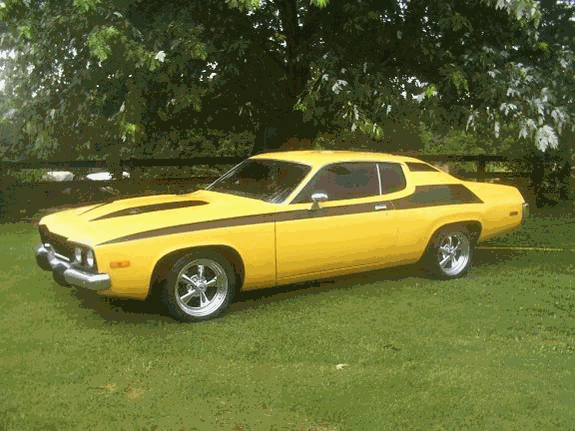
~1969 Plymouth Roadrunner, Yellow.
More extreme colors such as yellow and purple became common during
the "Muscle Car era"
|
The 1960s were characterized by an enhanced
interest in performance. Known as the muscle car era, every
automaker in the US tried to produce cars with the most powerful
engines possible. While more traditional cars such as family
sedans and wagons continued to use shades of colors commonly
seen in the 1950s, many sports cars and coupes featured more
exuberant, less conventional shades of colors such as red, green,
and blue. In addition, colors such as bright yellow, and violet
found their first mainstream automotive applications during
this decade. Models such as the Ford Mustang, Pontiac GTO, and
the Plymouth Barracuda are examples of colors featuring some
more nontraditional colors. Two-toned paint decreased in prominence
during the 1960s.
The 1970s saw the involvement of the US
government in automotive affairs. Due to the dual energy crises
of the 1970s, most automobiles sold in the American market became
more compact and fuel efficient. With a post-Vietnam world view
and environmental issues coming to the fore, many American consumers
became more health and environment-conscious. There was a greater
popularity of "Earth tones" during this period, which
included shades of olive green, brown, and tan or cream. The
prominence of the Earth tone colors for automobiles was in great
contrast to the less restrained colors available during the
1960s.
|
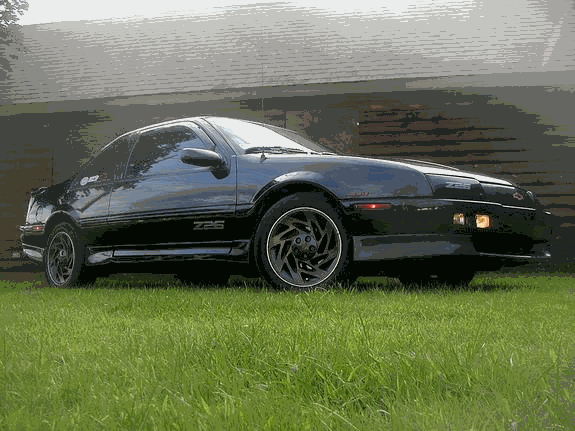
1988 Chevrolet Beretta, Black. Black was a very popular
color during the 1980ís.
|
The 1980s and 1990s were marked by great changes.
The 1980s was marked by the rise of a more traditional approach
in regards to color, with black and bright red being the most
favored colors of the period. The period also saw the rise of
the minivan as the favored vehicle of family transport and the
last major use of two-toned paint with synthetic faux external
wood panels. The 1990s was a period of growth for the Sport
Utility Vehicle (SUV). At the same time, it was also a decade
of renewed environmental consciousness. During this decade,
green (of all shades) was the most popular color, most likely
due to the greater environmental or natural interest. Fusion
colors, such as aqua, the fusion of blue and green, became common
and popular as well. In addition, two-tone paint reemerged on
some SUVs.
|
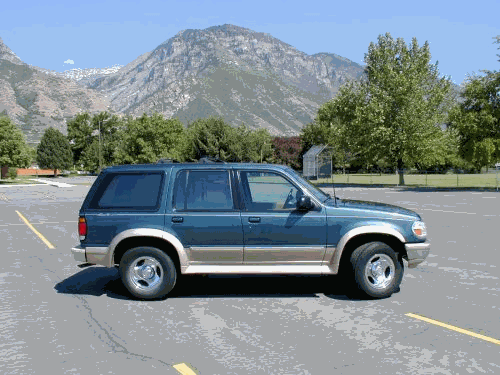
1996 Ford Explorer SUV, Green with beige.
Green was the most popular color the 1990s, and two-tone paint was
again popular with SUVs.
|
Even though the first decade of the 21st
century is still in progress, silver has been the most favored
color, for family sedans, sports cars, and SUVs, according to
the 2003 DuPont Automotive Color Popularity Report. An increased
interest in technology has been partially attributed to this
lighter-color preference. Furthermore, there has been an increased
interest in red colors, with bluish hues, as well as white pearl
metallic, and black metallic. Interestingly enough, the same
color that was the only color available for 12 years on the
Ford Model T Ė Black Ė is now the 3rd most popular
color for cars today, especially luxury models. Analysts believe
buyers choose black today especially for their luxury cars and
SUVs because they give a feeling of mystery and intrigue. According
to BASF: The Chemical Company, in the next few years, the basic
colors of white, black, blue, teal, green, brown, red, and silver
will continue to predominate in automotive color, but the blues
will become darker and more jewel-like, and the browns will
become more copper-like. Color trends in the near future can
reported because it takes about 3-4 years from the time a new
automotive pigment is introduced to the time it is implemented
on a production car.
|
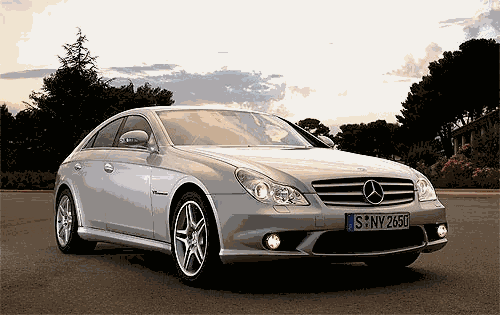
2006 Mercedes-Benz CLS-Class, Silver.
Silver has become the most popular color of the first few years of
the 21st century,
with silver metallic and black metallic the favorite for luxury cars.
|
The evolution of color in the American automotive
industry has been determined by economic issues facing the manufacturer,
the national mood, and consumer taste. These three factors have
affected the colors available at any point in time in the last
century. These factors also explain the divergence from the
initial 4 to 5 colors available in cars (including black), to
the current diversity of color. While color trends may help
predict the immediate future, these three factors can also help
track the evolution of automotive color preferences in the long-term
future. In a way, the three factors described are not exclusive
to just the evolution of colors in the American automotive industry.
Outside events and factors, coupled with peopleís own tastes
and beliefs, will always affect their preferences and the evolution
of choices they make throughout life.
|
|